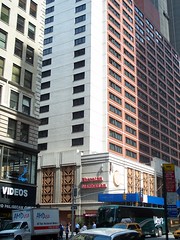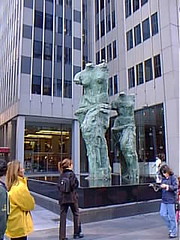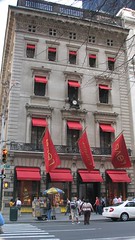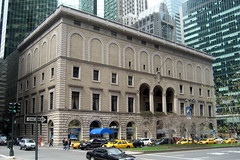North:
75: Was The Three Deuces,
jazz club named for a popular Chicago jazz club located
at 222 North State Street. Dizzy Gillespie's gigs
with Charlie Parker here in 1944 helped
popularize bebop.
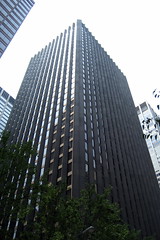
51 (corner): The 38-story
headquarters of the CBS network, built
in 1965 as the only skyscraper designed by
Finnish-born
Eero Saarinen, architect of Dulles Airport
and the St. Louis arch. The nickname
comes from the imposing, triangular black
granite pillars that run the length of the
building. It was the first New York highrise
to have a reinforced concrete (rather than
steel) frame.
(44 W 53rd): E.F. Hutton Building
37: In 1948,
Marlon Brando lived on the second
floor of a brownstone here, in a room furnished
with matresses, barbells, bongos and a hi-fi--
and not much else.
35: The original location of
The Onyx, opened as a speakeasy in 1927.
On March 1, 1935, this became The Famous Door,
a club bankrolled by jazz musicians,
including Glenn Miller and Jimmy Dorsey.
The eponymous door was kept next to the bar,
signed by the club's backers and other
notables who came to the club. No one
knows what became of it when the club closed.
Louis Prima was a headliner here; Billie Holiday
made her Swing Street debut.
33: After Prohibition ended in 1933, Leon
& Eddie's moved across the street to this address.
It became one of Swing Street's most prestigious clubs,
featuring performers like
Jackie Gleason,
Alan King and
Eydie Gorme. Closed in 1953.
25: Or, as Troy McClure calls it,
the Museum of TV and Television. (Officially,
it's now the Paley Center for Media.) You
can go and view old episodes of TV shows
here, which was more amazing in the days before
YouTube and Netflix. Founded 1975.
21:
Jack and Charlie's '21' Club
opened as a speakeasy on New Year's Eve, 1929,
after Jack Kriendler and Charlie Berns'
previous establishment on 49th Street
was bought out by Rockefeller Center.
Walter Winchell got kicked out and provoked
a raid with his column, after which ingenious
liquor-destroying devices and a secret wine
vault were installed. Mayor Jimmy Walker had
a discreet private booth in the cellar.
Humphrey Bogart and Lauren Bacall had their
first date here; Ernest Hemingway was caught
with Legs Diamond's girlfriend in the kitchen;
John F. Kennedy ate here the night before
his inauguration. (Every president since
FDR has visited here--save George W. Bush.)
Other regulars have included Alfred Hitchcock, Salvador Dali,
Dorothy Parker, Lillian Hellman, Joan Crawford
and Aristotle Onassis.
Margo Channing runs
into Eve Harrington here in All About Eve;
J.J. Hunsecker eats with Sidney Falco here in
The Sweet Smell of Success, as do the Michael Douglas
and Charlie Sheen characters in Wall Street
and Carrie Bradshaw and Mr. Big on Sex and
the City. Jimmy Stewart
gets take-out from here in Rear Window.
The building dates back to 1872. The jockeys
out front are a tradition dating back to the
late 1930s; many of them represent famous horses.
7: A three-story brownstone here,
owned by a woman named Chan Richardson,
served as a crash pad for jazz musicians in the
1940s. One of them,
Charlie "Bird" Parker, became
her lover and lived with her here in the
late '40s.
Corner (666 5th Ave): This was the address of the
mansion of
William Kissam Vanderbilt Jr., great-grandson of
the Commodore, an auto-racing enthusiast who
founded the Vanderbilt Cup. The 1905
mansion, designed by McKim, Meade and White, was the
last of the Vanderbilts' Fifth Avenue mansions.
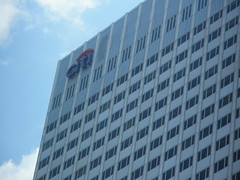
In 1957, an
aluminum- clad office building
with an apocalyptic address
was put up here with a million square feet
of space; the lobby waterfall was designed by
Isamu Noguchi. Brooks Brothers, founded 1818,
is on the ground floor, along with
Hickey Freeman and the NBA Store.
Top of the Sixes, the top-floor restaurant, is
now the Grand Havana Room, a private cigar club.
Corner (660 5th Ave):
William Kissam Vanderbilt Sr.,
son of William H., grandson of the Commodore,
and "the" Vanderbilt after the
death of his brother Cornelius II, was one of the first
Vanderbilts to live on Fifth Avenue, living in
the Petit Chateau, a mansion designed by Richard Morris Hunt
and built from 1879-82 and demolished in 1926.
| 